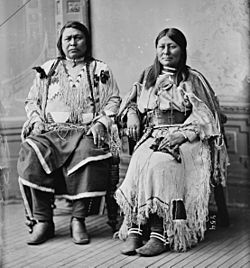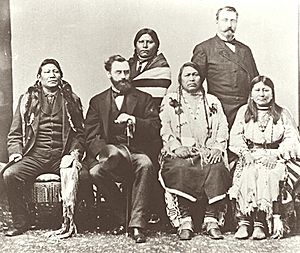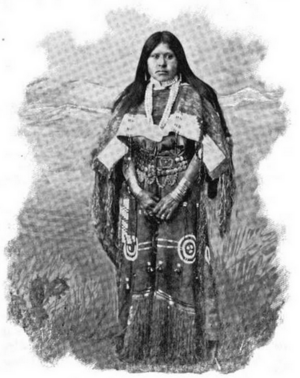Chipeta facts for kids
Quick facts for kids
Chipeta
|
|
|---|---|

Chipeta and her husband Chief Ouray,
wearing a shirt she beaded |
|
| Born | 1843 or 1844 |
| Died | August 20, 1924 |
| Nationality | American |
| Other names | White Singing Bird |
| Known for | Ute tribal leader and wise woman |
| Spouse(s) | Chief Ouray |
Chipeta (also known as White Singing Bird) was an important Native American woman. She lived from about 1843 or 1844 to August 1924. Chipeta was the second wife of Chief Ouray, a leader of the Uncompahgre Ute tribe.
She was born into the Kiowa Apache tribe. However, she was raised by the Ute people in what is now Conejos, Colorado. Chipeta was a trusted advisor to her husband. She continued to be a leader for her people even after he passed away in 1880.
Chipeta worked hard for the rights of Native Americans. She was also a skilled diplomat. She used peaceful talks to try and get along with the white settlers in Colorado. In 1985, Chipeta was honored by being added to the Colorado Women's Hall of Fame.
Contents
Who Was Chipeta?
Chipeta means "White Singing Bird" in the Ute language. She was born around 1843 or 1844. She was adopted and grew up with the Uncompahgre Utes in Colorado. She learned their traditional ways of life. Chipeta became very good at beadwork and tanning animal hides.
In 1859, she married Chief Ouray. She became his second wife. Chipeta was his close advisor and friend. She often sat with him during tribal council meetings. In 1863, Chipeta and Ouray helped create the first treaty in Conejos, Colorado.
Chipeta was known for her beauty. She could play the guitar and sing in three different languages. Her beadwork was also very famous.
Helping Others
Chipeta was known for her kindness. Once, she learned that some Utes planned to raid white settlers. She quickly rode her pony and swam the Gunnison River to warn them. This saved their lives.
Another time, she rescued a white woman and her children. They were in danger from other Utes. Chipeta rode for four days to help them. The family later said that Chipeta and Chief Ouray made them feel very safe and comfortable. Chipeta even cried tears of sadness for them. Both Chipeta and Ouray often helped white settlers find their way through the wilderness.
Chipeta never had her own children. However, she adopted four children and raised them as her own. Some stories say she did have one son who was taken by a group of Kiowas.
A Ute Leader and Wise Woman

Chipeta wanted the Ute people to live peacefully with the white settlers. But problems were growing. Settlers were hunting animals that the Utes needed for food. Also, the government wanted the Utes to start farming. They also wanted them to stop horse racing and become Christians.
These tensions led to an uprising in September 1879. This event is known as the Meeker Massacre. During this time, Utes killed 11 white men and took three women and two children captive. In a related battle at Milk Creek, Ute warriors trapped soldiers for several days.
The Uncompahgre Utes, Chipeta's tribe, did not join this uprising. A former US Indian agent, General Charles Adams, helped free the captives. One of the captives was Josephine Meeker, the daughter of the Indian agent who was killed. The freed captives were brought to Chipeta and Ouray's home.
Traveling to Washington D.C.
On January 7, 1880, Chipeta and Chief Ouray led a group of Utes to Washington, DC. They went to talk about a new treaty for their land. They also had to speak to Congress about the Ute uprising. When they tried to get on a train in Alamosa, an angry crowd of white people attacked them. The crowd thought they were involved in the Meeker Massacre.
On March 7, 1880, Chipeta was welcomed by the Secretary of Interior Carl Schurz at the US Capitol. She spoke to a group in Congress about the Meeker Massacre. She answered 10 questions through an interpreter.
The Utes signed a treaty with the US government. But they were forced to leave Colorado. They had to move to a reservation in Utah. Both the White River and Uncompahgre Utes were moved. After the Ute Removal Act of 1880, Chipeta and other Utes moved to the Uintah Indian Reservation in Utah. Chief Ouray had died earlier that year. After his death, the reservation was renamed to honor him. Chipeta continued to be a respected leader and wise woman among the Utes.
Life on the Reservation
Chipeta was very respected on the reservation. The government had promised to build her a nice house. But this never really happened. Instead, they gave her a small two-room house on the White River with no furniture. This house was in a place where she could not grow food. So, Chipeta had to rely on food given to her by government officials.
Even with the house, she often used her teepee. She lived in the traditional way, alongside other Ute people. Officials sometimes had to turn away people who tried to get Chipeta's food rations. Chipeta was always kind and thankful for what the government officials did for her. She was never demanding.
She lived her life until the end as a traditional elder. She followed the old ways, lived in a teepee, and wore traditional clothes. Her tribe supported her. Once, she was given over 100 dollar bills. She gave them away to others who needed them more. Money was not important in her daily life.
Chipeta was also highly respected by her tribe. She was always allowed to attend council meetings. No other Ute woman was usually allowed there. When she had guests, Chipeta would cook meals herself. She used her own tools and did not need help from other women. Chipeta became blind when she was older.
Death
Chipeta passed away from a stomach illness called chronic gastritis on August 20, 1924. This happened at the Uintah and Ouray Reservation in Utah. Her community buried her in a traditional way, without a box.
In 1925, a Ute Indian agent named F.A. Gross got permission from Chipeta's brother, John McCook, to move her body. They wanted to give her a proper tomb. On March 15, 1925, she was reburied at her former home near Montrose, Colorado. Her new burial site, the Ouray Memorial Park, was honored by 5,000 guests. They came to pay their respects on the day of the move. On May 25, 1925, the remains believed to be Chief Ouray's were also reburied in the cemetery on the Southern Ute reservation.
See also


